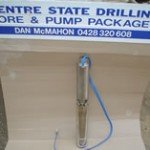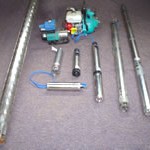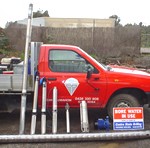Pump selection for your new or existing bore depends on several criteria. Volume and pressure required, depth and yield of bore, application, power available, efficiency and importantly, reliability.
The most important aspect of any bore and pump is that they be matched to suit. There is no point installing a 50lpm pump in a bore that is only producing 30lpm. Indeed it will be detrimental to both the bore and the pump if this is done. It is always best to install a pump of slightly less capacity than the yield of the bore. A 30lpm bore should have a 20 or 25lpm pump, no more.
Volume and pressure required will obviously vary depending on application, whether the water is going into storage such as a tank or dam, or whether the water will be used directly from the bore. If the water is to be used directly from the bore then will the water be used via sprinklers, drippers, open hose or other uses? First having a good idea as to the way you would like to use the water will aid in choosing the pressure and volume required from your pump.
The depth and yield of the bore will dictate, to a certain degree, especially if it is a low yielding bore, the size and type of pump that will best suit the bore. Yields from low yielding bores can be maximized with bore level controls fitted to the pump. These controls allow the pump to run until the water level is within a few feet of the pump and will then shut off the pump, reinstating the pumping when the bore has recharged to a safe level. Not only does this protect the pump from running dry, it also allows the pump to cycle its pumping to attain maximum yield from the bore.
Application of water use will affect the pressure rating required and the control system of the pump. A simple pressure control module will suffice for most applications as it will make the pump “start on demand”, that is, the pump will start automatically when a tap is turned on and stop when a tap is turned off. If the application will be for tank filling then the process can quite simply be automated to turn the pump on when the water level of the tank starts to fall and when the tank is full, then the pump will turn off automatically.
Power available is important as a poor power supply in some rural areas can cause headaches, especially with power surges. Most domestic systems run on single phase household supplies, with larger commercial or irrigation systems requiring three phase power, either mains or generator, to utilize high yields of water, 250lpm or more.
Windmills have been in use for generations, especially when there is no power available. Although initially costly in comparison to electric pumps, windmills use free energy and with a minimum of maintenance, will provide a reliable pumping solution for many years to come.



